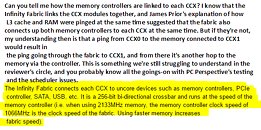Friday, March 17th 2017

AMD Ryzen Infinity Fabric Ticks at Memory Speed
Memory clock speeds will go a long way in improving the performance of an AMD Ryzen processor, according to new information by the company, which reveals that Infinity Fabric, the high-bandwidth interconnect used to connect the two quad-core complexes (CCXs) on 6-core and 8-core Ryzen processors with other uncore components, such as the PCIe root-complex, and the integrated southbridge; is synced with the memory clock. AMD made this revelation in a response to a question posed by Reddit user CataclysmZA.
Infinity Fabric, a successor to HyperTransport, is AMD's latest interconnect technology that connects the various components on the Ryzen "Summit Ridge" processor, and on the upcoming "Vega" GPU family. According to AMD, it is a 256-bit wide bi-directional crossbar. Think of it as town-square for the chip, where tagged data and instructions change hands between the various components. Within the CCX, the L3 cache performs some inter-core connectivity. The speed of the Infinity Fabric crossbar on a "Summit Ridge" Ryzen processor is determined by the memory clock. When paired with DDR4-2133 memory, for example, the crossbar ticks at 1066 MHz (SDR, actual clock). Using faster memory, according to AMD, hence has a direct impact on the bandwidth of this interconnect.
Source:
CataclysmZA on Reddit
Infinity Fabric, a successor to HyperTransport, is AMD's latest interconnect technology that connects the various components on the Ryzen "Summit Ridge" processor, and on the upcoming "Vega" GPU family. According to AMD, it is a 256-bit wide bi-directional crossbar. Think of it as town-square for the chip, where tagged data and instructions change hands between the various components. Within the CCX, the L3 cache performs some inter-core connectivity. The speed of the Infinity Fabric crossbar on a "Summit Ridge" Ryzen processor is determined by the memory clock. When paired with DDR4-2133 memory, for example, the crossbar ticks at 1066 MHz (SDR, actual clock). Using faster memory, according to AMD, hence has a direct impact on the bandwidth of this interconnect.

95 Comments on AMD Ryzen Infinity Fabric Ticks at Memory Speed
There is a Reason the Ryzen Logo is an Incomplete circle, it means the arch is open to improvements big and small.
Is there room for improvement? Yep. Will it cost you a new motherboard and CPU in the near future? Yep.
Thanks for clarification. Well then in this case the only thing is to get the memory with higher frequency although I'm wondering now if it is worth additional money? Will this better performing memory really make noticeable difference. From a consumer stand point this difference should be noticeable if you wanna go with good 3200Mhz mem. Otherwise it's pointless.
look at back, Intel C2Q, Pentium D linked via FSB speed, but ultimately dropped it
AMD need to make real 'individual' cores, with shared L3 cache across 8 cores like Intel do
I dont know, maybe AMD try to save R&D cost by making 'blue print' of 4 cores configuration and simply 'copy-paste' cores to silicon
Tired of anything related to modules with slow interconnects.
Look back at the old G4 chips in classic Macs. In the generation where there was a switch from the 7410 to the 7450, the 10s held a performance advantage due to shorter data paths. The 50s didn't get anywhere till the 55s when they brought in L3 and found ways to negate the longer paths. But Motorola couldn't just go back to the 7410s at the time. They'd only clock up to 600-650Mhz. The pathways being so short causes problems with running faster than that. Apple was in the big push to 1Ghz back then so, they opted to go with the less optimal 50s in order to get the Mhz.
Limitations in a design, forced the engineers to adopt a less optimal design. People really didn't know about it till the more hardcore Mac clockers got into the designs and really analyzed it. Which took longer back then than these days.
AMD X370
Support for DDR4 3600(O.C.) / 3400(O.C.) / 3200(O.C.) / 2933(O.C.) / 2667* / 2400 / 2133 MHz memory modules
GA-Z270-Gaming K3
Support for DDR4 3866(O.C.) / 3800(O.C.) / 3733(O.C.) / 3666(O.C.) / 3600(O.C.) / 3466(O.C.) / 3400(O.C.) / 3333(O.C.) / 3300(O.C.) /3200(O.C.) / 3000(O.C.) / 2800(O.C.) / 2666(O.C.) / 2400 / 2133 MHz memory modules
link. www.gigabyte.com/Motherboard/GA-Z270-Gaming-K3-rev-10#sp
link. www.gigabyte.com/Motherboard/GA-AX370-Gaming-K7-rev-10#sp
This is a core cluster to core cluster thing, normalmemory isn't even involved.
Runs at memory frequency is quite a revelation, actually, what you state doesn't cover it like, at all.They might do that, once people will actually start buying their products and they have more money to spend on R&D.
Feel free to correct me if im wrong but do it in an nice way :)
In fact can anyone name application where this WILL be a problem (granted that the scheduler understand the CCX architecture.) Im not trying to be smart or anything but I cant come up with one where this would actually be a limit (granted that the architecture was taken into account.)
Also a question, could this Infinity Fabric in theory enable on-die Crossfire/SLI connection between two GPUs, removing (or reducing) the need for software?